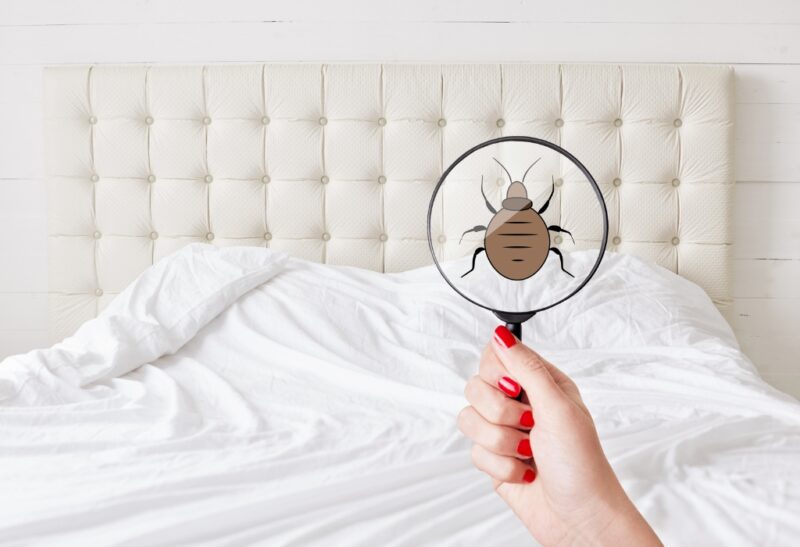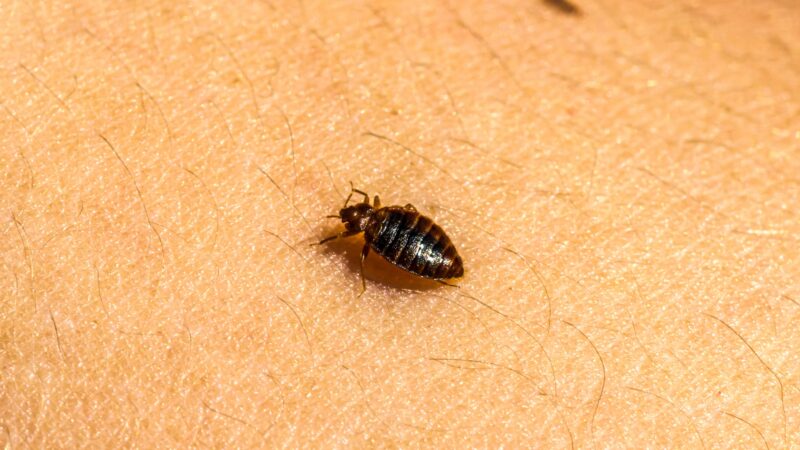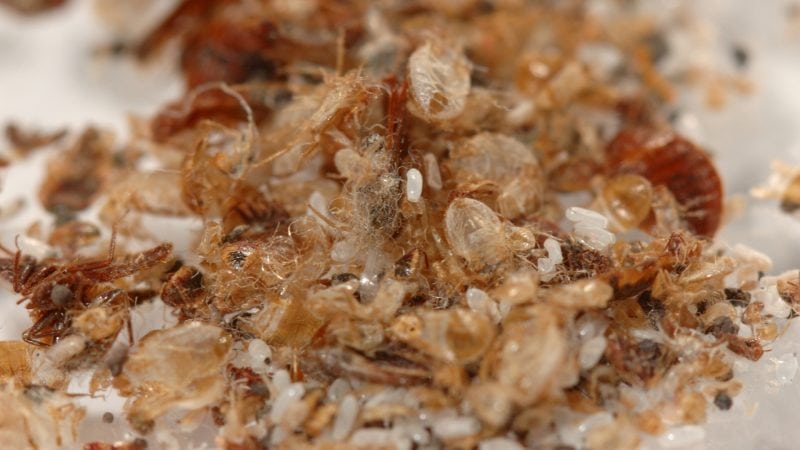It can be challenging to stop bed bug infestations from spreading. How to lessen the frequency of mating continues to be studied in the latest studies on bed bug lifecycle. Understanding bed bug mating behaviors is useful for understanding how they spread.
How do bed bugs reproduce? The act of bed bug reproduction is called “traumatic insemination”. The process begins with the male bed bug stabbing the abdomen of the female with a peculiar hard reproductive organ. By stabbing her, the organ opens a crack in the shell of a female bed bug, and through that crack injects sperm into the body cavity. The sperm flows through the female body, and as a result, it fertilizes the eggs.
Female bugs can get hurt by frequent reproducing, so they will even sometimes hide from the possible mating processes. The process of laying eggs takes 6 to 8 weeks. The bed bug life cycle is very interesting, so we suggest you stay with us and read the article until the very end.
What Is A Traumatic Insemination?
Males pierce the female abdomen and inject sperm into their bloodstream. Through blood, it goes directly into the ovaries, and there the fertilization of the eggs happens. This is adopted as the only method of mating with bed bugs, traumatic insemination. This whole process has a clearly negative impact on female bed bugs. It reduces their life span and it even decreases their reproductive output.
Why? Because bed bugs need time to repair the wound, and stop the bleeding. That method also has a higher risk of infection through the wound. Female bed bugs have an evolved reproductive organ called spermalege. It consists of two different parts called ectospermalege and mesospermalege.
So How Are There So Many Bed Bugs?

Before fertilization can happen, bed bugs need to feed themselves and shed their skin 5 times. For that to happen, it takes around 37 days – in case the bed bugs can find a host to feed on regularly. After the fertilization of the female happens, she will be carrying eggs from 6 to 8 weeks, but she will lay the first eggs after just 3 days.
Research showed that the males are likely to reproduce with recently fed female bugs because their outer membrane is thinner and easier to pierce. The act of fertilization leaves the female bug scared.
The female bed bug is also feeding herself during the whole process of egg carrying. Sometimes, she is distancing herself from her mates so she could feed herself better. By doing so, they lay more eggs.
By distancing herself from the male bed bugs, she will also minimize the chance of getting hurt by constant reproduction cycles. While she is distancing herself, she is also preserving the eggs by allowing herself to feed regularly. By doing so, she is caring for the eggs in the best possible way by giving them enough time and food to develop correctly. If the process of bed bug reproduction was different, she would probably have fewer hatching cycles and fewer eggs in each cycle.
On average, in a one-bed bug reproduction cycle, 3 to 8 eggs are laid every week. In perfect conditions, that number goes up to 12 eggs per day! It takes 6 to 9 days for eggs to hatch. Immediately after hatching the young bed bugs, their feeding process begins. When you know the information that the female bug lays on average 200 to 250 eggs in her lifetime, you can understand how we haven’t found a way to deal with them during all this time.
There were even cases where one female bed bug laid over 500 eggs in her lifetime. It is very hard to fight that many bed bugs! Even if you try, the bed bugs will give you a hard time because they will not lay their eggs just in plain sight. They will find a place that is very hard to reach, like cracks in the walls, electric outlets, or under the furniture
Temperature As A Factor For Successful Bed Bug Reproduction
The temperature of the inhabited space is one of the crucial elements for fruitful bed bug reproduction. If the warmth is 70°F/21°C or above, around 60 percent of eggs will be hatched by day 6. Somewhere around day 9, around 90% will be hatched. If the temperature goes down, it will increase the time needed for the egg to hatch.
The ideal temperature is between 70°F/21°C and 90°F/32°C, under those conditions, bed bug number will be in most cases doubled. Those temperatures are common in human homes, so we can say that bed bugs evolved alongside humans and they adopted our habits. They are inside in the warm, and they don’t need to go through harsh weather conditions outside. We are a perfect host for these pests.
Can Female Bed Bugs Lay Eggs Without Mating?

It is impossible for the female bed bug to lay eggs without mating. One strange thing about female bed bugs is that they can store sperm, and choose the time to fertilize the eggs.
Before laying the eggs, a female bed bug needs first feed herself. Also, when the sperm has been used up, she needs to mate again in order to lay more eggs. Sometimes if she lives for a longer period, one of her offspring will mate with her and the cycle will continue until the female bed bug dies.
Is It Possible for Male Bugs to Lay Eggs?
It is impossible for male bugs to lay eggs. Male bed bugs lack the female organs needed to create and store eggs. Females, on the other hand, don’t have the organs needed to fertilize the eggs. So there is an absolute need for males and females in the whole process from fertilization to laying off the eggs.
Do Bed Bugs Have Some Sort of Mating Season?
Bed bugs do not have some sort of mating season. Even when outside is cold or in the winter season, it won’t affect bed bugs because they are in your home, and the temperature is ideal for their mating. That is one of the main reasons why bed bugs are regularly choosing humans as their hosts. The best time for mating is right after they feed off the host, so you can now understand why their numbers are constantly great.
Do the Bed Bugs Use Their Host as a Place for Laying Eggs?
Bugs are attracted to their hosts only when they want to feed. They don’t want to lay their eggs on the host because that would be risky for the eggs and for the bed bugs themselves.
Humans would easily get rid of bed bugs by just sweeping them off the skin. They don’t have any kind of claws with which they could use to hold on to some part of the host (like lice), so the answer is definitely no.
Some Facts On Bed Bugs Reproduction

- The warmer environment is a plus when it comes to bed bug reproduction. More eggs will be hatched if the temperature is higher.
- One female bed bug is enough to make your life miserable. With the tempo of reproduction, their number rises very fast.
- The best places for them to lay eggs are in hard-to-reach places, like cracked walls, floors, all kinds of installations in your home, attics, basements, and under and behind the furniture. You guessed it – all the places which are hard for us to inspect.
- Tropical bed bugs lay fewer eggs than the American ones. Tropical will lay somewhere around 50 eggs in their lifetime, while American bed bugs lay even 4 times more – 200!
Ways of Stopping Bed Bug Reproduction
The main problem with bed bugs is the speed of their reproduction. Also, they are small, adaptable to the environment, and hard to see. So with that information, you can say that it is pretty hard to stop a bed bug infestation.
In theory, you can treat bed bugs with pesticides right away, but you will need to be thorough. We made our list of recommended sprays for eradicating bed bugs. In fact, we made two different lists, one with the natural (eco) type of bed bug sprays and the other with regular bed bug sprays that are usually more effective. Whatever you chose from our list it will help you if you are having a small to medium infestation. But if you are having a huge bed bug infestation, the best way would be to hire professionals.
List of Sources
Traumatic insemination and sexual conflict in the bed bugs Cimex lectularius. University of Sheffield.
Morrow, E. H.., Arnqvist, G. (2003). Costly traumatic insemination and a female counter-adaptation in bed bugs. Proceedings. Biological sciences.
Diseases & Conditions – Bedbugs, Mayo Clinic
- How to Get Rid of Copperheads | Practical Guide - August 27, 2023
- How to Get Rid of Corn Snakes | What Makes Them Aggressive? - August 27, 2023
- How to Get Rid of Alligators | Safety Measures and Removal Methods - July 16, 2023
